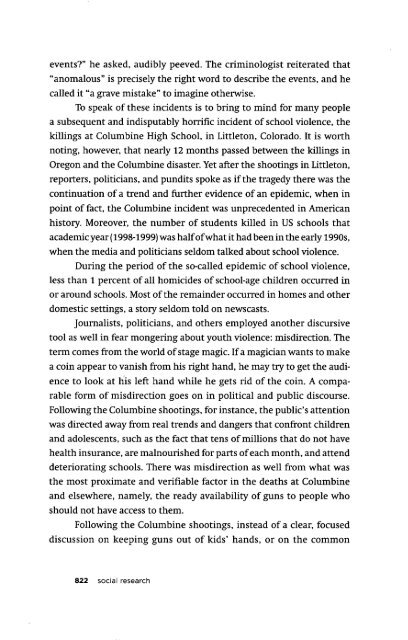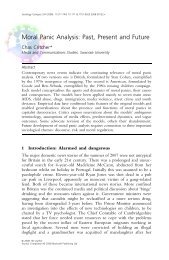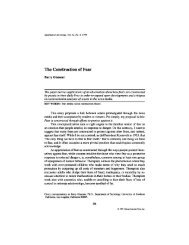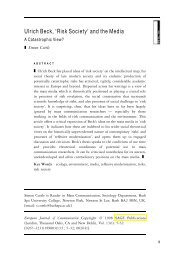Barry Glassner Narrative Techniques of Fear Mongering - Penelope ...
Barry Glassner Narrative Techniques of Fear Mongering - Penelope ...
Barry Glassner Narrative Techniques of Fear Mongering - Penelope ...
You also want an ePaper? Increase the reach of your titles
YUMPU automatically turns print PDFs into web optimized ePapers that Google loves.
events?" he asked, audibly peeved. The criminologist reiterated that<br />
"anomalous" is precisely the right word to describe the events, and he<br />
called it "a grave mistake" to imagine otherwise.<br />
To speak <strong>of</strong> these incidents is to bring to mind for many people<br />
a subsequent and indisputably horrific incident <strong>of</strong> school violence, the<br />
killings at Columbine High School, in Littleton, Colorado. It is worth<br />
noting, however, that nearly 12 months passed between the killings in<br />
Oregon and the Columbine disaster. Yet after the shootings in Littleton,<br />
reporters, politicians, and pundits spoke as if the tragedy there was the<br />
continuation <strong>of</strong> a trend and further evidence <strong>of</strong> an epidemic, when in<br />
point <strong>of</strong> fact, the Columbine incident was unprecedented in American<br />
history. Moreover, the number <strong>of</strong> students killed in US schools that<br />
academic year (1998-1999) was half <strong>of</strong>what it had been in the early 1990s,<br />
when the media and politicians seldom talked about school violence.<br />
During the period <strong>of</strong> the so-called epidemic <strong>of</strong> school violence,<br />
less than 1 percent <strong>of</strong> all homicides <strong>of</strong> school-age children occurred in<br />
or around schools. Most <strong>of</strong> the remainder occurred in homes and other<br />
domestic settings, a story seldom told on newscasts.<br />
Journalists, politicians, and others employed another discursive<br />
tool as well in fear mongering about youth violence: misdirection. The<br />
term comes from the world <strong>of</strong> stage magic. If a magician wants to make<br />
a coin appear to vanish from his right hand, he may try to get the audience<br />
to look at his left hand while he gets rid <strong>of</strong> the coin. A comparable<br />
form <strong>of</strong> misdirection goes on in political and public discourse.<br />
Following the Columbine shootings, for instance, the public's attention<br />
was directed away from real trends and dangers that confront children<br />
and adolescents, such as the fact that tens <strong>of</strong> millions that do not have<br />
health insurance, are malnourished for parts <strong>of</strong> each month, and attend<br />
deteriorating schools. There was misdirection as well from what was<br />
the most proximate and verifiable factor in the deaths at Columbine<br />
and elsewhere, namely, the ready availability <strong>of</strong> guns to people who<br />
should not have access to them.<br />
Following the Columbine shootings, instead <strong>of</strong> a clear, focused<br />
discussion on keeping guns out <strong>of</strong> kids' hands, or on the common<br />
822 social research





